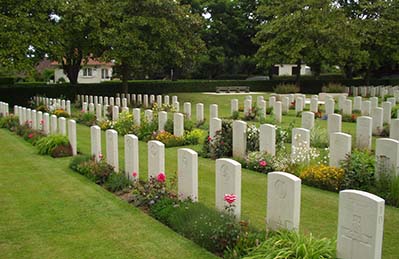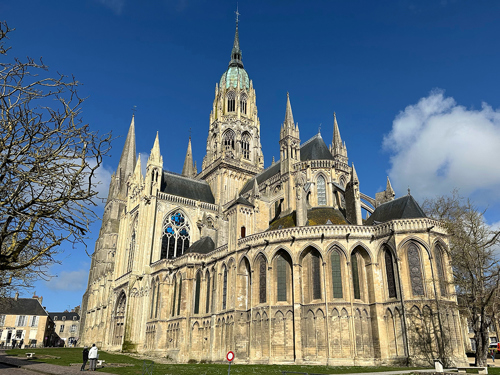24 May 2024
Reflecting on the Legacy of D-Day 80 years on
The Legacy of D-Day is far-reaching. Discover the importance of this major historical event and how it is commemorated with Commonwealth War Graves.
How Did D-Day Impact the Second World War?

Image: British soldiers aboard their landing craft on their way to Gold Beach on D-Day ((Image IWM (BU 1181))
How Did D-Day Impact the Second World War?
80 years on from D-Day, we are taking time to evaluate the impact this most momentous of military campaigns had on the wider course of the Second World War.
The name and date of D-Day loom large in the public imagination, some eight decades after the fact, but why?
Simply put, the Invasion of Normandy was one of the most significant events of World War Two.
Before the invasion even began, the threat of a major Allied offensive was enough to impact German strategy.
Millions of resources were poured into the Atlantic Wall defences: a strip of German fortified positions, emplacements and beach defences built across the French Atlantic coast.
On 6 June 1944, more than 150,000 Allied troops stormed the beaches of Normandy. D-Day, the opening day of Operation Overlord, was the largest seaborne invasion in history.
D-Day put the Allies on a decisive march towards victory. With the beach landings and subsequent Battle for Normandy, the Allies handed Nazi Germany a crushing defeat comparable with Stalingrad and North Africa.
Hundreds of thousands of German soldiers and thousands of vehicles had been transferred to Normandy to throw the Allies back into the sea.
This helped relieve pressure in other areas, particularly the Eastern Front where the Soviets were advancing rapidly.
Most of the German troops committed to the defence of France were either destroyed during the battle or forced into surrender.
Some 610,000 Wehrmacht soldiers and thousands of vehicles were committed to Normandy. 30,000 were killed, 80,000 wounded, and 210,000 either went missing or were taken captive by the end of the battle.
What happened after D-Day?

Image: A Cromwell tank of 7th Armoured Division (the Desert Rats) on the Bremen-Hamburg autobahn, 20 April 1945 (IWM (BU 4166))
Within a year of D-Day, Nazi Germany had surrendered.
The Normandy Campaign, aka Operation Overlord, would grind on for two months following the Normandy beach landings.
It ended in late August 1944 with the closing of the Falaise Gap and the encirclement and destruction of the German 7th Army and 5th Panzer Army.
Paris was liberated on 25 August and so France was considered firmly back in Allied control.
With a firm foothold in Europe finally established in France and Italy (Italy having been invaded in mid-1943), the Allies were able to mount various campaigns and offensives to try and end the war.
Of these, perhaps the most infamous is Operation Market Graden: an airborne-led assault to capture key bridges in the southern Netherlands to cross the Rhine and head into Germany.
Market Garden was only partially successful. The southern part of the Netherlands was liberated but the advance stalled at Arnhem at great cost. Another way into Germany would have to be found.
The Allied invasion of Germany took place on March 22, 1945. By 8 May, the German Army had surrendered and the war in Europe was over.
How did D-Day impact the world?
The road to Germany was opened on the beaches of Normandy on June 6, 1944.
D-Day’s global impact is huge.
It is one of the most significant events of the Second World War and 20th-century history as a whole.
D-Day was the start of the Allied advance that would ultimately end in the liberation of Europe.
What is D-Day remembered for?
D-Day is remembered for many reasons.
Firstly, it is the largest amphibious assault in history. The sheer volume of soldiers, aircraft, naval vessels, and supplies is staggering.
D-Day is also remembered for the experiences of the men on the beaches.
Films like The Longest Day and Saving Private Ryan have vividly brought some action of the beach action to vivid life, while the testimonies of those who were there are some incredible pieces of first-person history.
The impact of D-Day is also remembered for its contemporary significance. The success of such a major campaign, one which Churchill called the most complex in history, convinced German High Command that total defeat was inevitable.
Was D-Day worth the sacrifice?

Image: British soldiers share a drink with jubilant Parisians following their city's liberation (IWM (BU 26))
"Everything was at stake," Robert Citino, the senior historian at the National WWII Museum in New Orleans, told CBS regarding D-Day’s importance. "World War Two had been raging now for five years, and it was time to bring it to an end. Every month it extended it was more death, more mass murder, starvation. The situation couldn't have been more dire."
D-Day was a major success but not without cost. By the end of June 6, the Allies had lost around 10,000 men killed. Over 4,000 had been killed on the beaches before even getting inland.
Normandy was a bloody, hard-fought campaign. Over 220,000 Allied servicemen were killed, went missing, or were wounded from D-Day to the closing of the Falaise Gap on 21 August 1944.
Ultimately, those who gave their lives paved the way for the eventual Allied victory and liberation of Europe. D-Day’s impact, based on the outcome, is immeasurable.
How can we commemorate their sacrifice 80 years on from D-Day?
Attending D-Day anniversary events and tours

Image: The Torch of Sacrifice
As we approach the 80th Anniversary of D-Day, the Commonwealth War Graves Commission’s Legacy of Liberation will be marking the occasion with a series of major events taking place at our sites in the UK and in Normandy.
The Lighting Their Legacy events will reach people across the UK, Italy and France.
These momentous events aim to build connections between veterans and young people and bring people together to pass the Torch of Commemoration to the next generation.
The Great Vigil will see every CWGC war grave in Normandy lit up in commemoration of those who fell on D-Day and in Normandy with a stunning illuminated experience.
Visiting historical D-Day sties

Image: Gold Beach as it stands today
The beaches of Normandy are major tourist attractions and freely open to the public. Today, they still show reminders of the massive effort made to take and defend the beach by both sides.
Normandy is full of historical sites related to D-Day and Operation Overlord. The remains of the Atlantic Wall, including bunkers, control towers, and artillery emplacements are clearly visible.
The towns along the seafront hold museums and places of historical interest that tell the D-Day story. For instance, the Juno Beach Centre is a Canadian non-profit museum, focussing on the Canadian efforts on D-Day. It’s one of just many places to visit on a trip to the D-Day beaches.
Guided tours run by battlefield guides are also available. Commonwealth War Graves does not currently partner with any tour operators in Normandy, however.
Visiting war cemeteries and memorials
The Commonwealth War Graves Commission maintains many constructed sites in Normandy.
They show us the impact of D-Day went beyond the military side. It had a real cost in human life.
Some of the key CWGC cemeteries and memorials commemorating Normandy casualties of World War Two are:

Ranville War Cemetery
As touched on earlier, Pegasus Bridge was one of the key battles of the Normandy Invasion’s early stages.
The village of Ranville, close to Pegasus Bridge, was one of the first villages to be captured by the Allies on D-Day. It now holds one of the largest CWGC war cemeteries in Normandy, holding 2,500 war graves.

Hermanville War Cemetery
Hermanville War Cemetery lies less than a mile from Sword Beach.
Just over 1,000 war graves can be found at Hermanville. Nearly all of the soldiers buried here were killed in the early days of June 1944.

Bayeux War Cemetery
Bayeux was spared from most of the fighting in Normandy, but it was one of the earliest towns to be liberated.
Bayeux War Cemetery is the largest CWGC cemetery in Normandy, holding over 4,100 Second World War graves.
The Bayeux Memorial commemorates by name a further 1,800 Normandy casualties who have no known war grave.

Beny-sur-Mer Canadian War Cemetery
Some 2,000 Canadian servicemen are buried at Beny-sur-Mer Canadian War Cemetery. It lies some two miles inland from the Normandy beaches, near the village of Reivers.
Most of the men buried here were killed during the assault on Juno Beach, or in the advance on Caen. Caen was an important transport hub and the site of much bitter fighting in the summer of 1944.

Ryes War Cemetery
Located a little way inland from Gold Beach, Ryez War Cemetery lies in the village of Bezanville. The first burials came in the days after D-Day when casualties were moved off the beach at Arromanches.
Over 650 Commonwealth burials, including D-Day war graves, lie within Ryes War Cemetery. The site also holds 300 or so German war graves, cared for by CWGC.

La Delivrande War Cemetery
Lying just over a mile inland from Sword Beach.
Those buried within died across the length of the Normandy Campaign, either on Sword Beach on D-Day morning, or in the thrust to Caen.
Overwhelming British, the cemetery also contains several German, Australian, Canadian, and Polish war graves.
Donate to keep their stories alive
The Commonwealth War Graves Foundation (CWGF) aims to engage and educate people – especially the young – with the work of the CWGC and the inspiring stories of the men and women who died whilst fighting in the two World Wars.
If you’d like to help us keep their stories alive please make a donation today.

The Commonwealth War Graves Foundation is our charitable arm. Discover more about their exciting projects, important mission, and how you can support the CWGF today.
Visit the Foundation
Lighting their Legacy
Across the UK, May & June
Discover our national programme of events and inspire the next generation.

The Great Vigil
Normandy, 5 June
Join the culmination of our D-Day events as we illuminate every CWGC grave in Normandy.

DISCOVER OUR 80TH ANNIVERSARY WW2 EVENTS
We're holding a number of events across the UK and in Normandy in the build up to the 80th anniversary of D-Day. Find out more about what we're planning and discover how you can get involved.
Find out more
